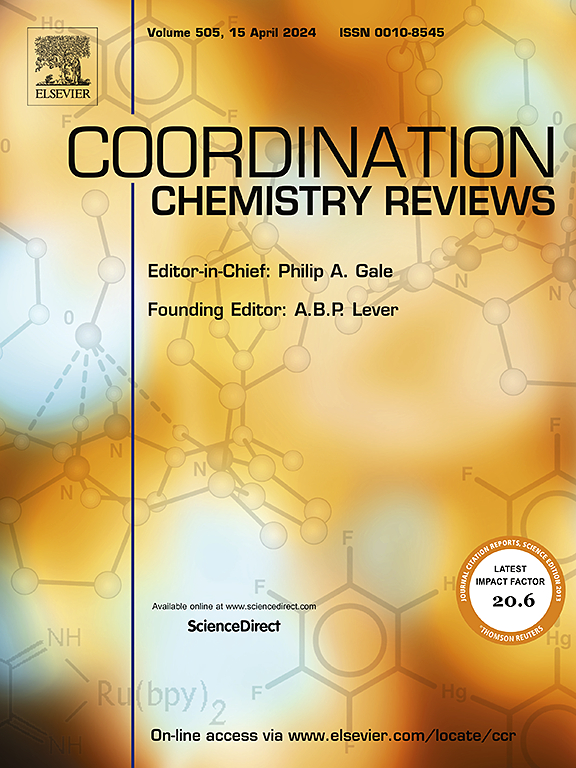分子自旋交叉材料的光学性质及光子应用
IF 20.3
1区 化学
Q1 CHEMISTRY, INORGANIC & NUCLEAR
引用次数: 0
摘要
本文综述了分子自旋交叉(SCO)材料在低自旋和高自旋电子构型之间可逆切换的光学性质,以及它们在光学和光子学领域的实际应用。我们专注于SCO材料中复折射率变化(实部和虚部)的物理起源和幅度,包括对较少研究的较低频率范围(太赫兹)的简短偏移。到目前为止,光学性质的变化主要被用作一种检测手段,以表征SCO现象本身(特别是在纳米尺度上)或开发用于监测外部刺激变化的光学传感器。然而,最近,利用SCO纳米材料作为可调谐光子器件中的有源元件,也探索了光信号处理和调制。在此,我们回顾了这种功能器件的现状,表明分子SCO化合物正在成为一类有前途的相变材料,在特定的有源光子应用中具有很高的潜力,特别是在可见光谱范围内。在光子器件的背景下,简要回顾了SCO材料的光诱导自旋跃迁和光开关动力学的关键结果。最后,本文还讨论了最近报道SCO分子与谐振光学腔中受限电磁场之间强光-物质耦合现象的研究结果,并展望了利用光操纵分子性质的迷人前景。本文章由计算机程序翻译,如有差异,请以英文原文为准。

Optical properties and photonic applications of molecular spin-crossover materials
We review the current knowledge on the optical properties of molecular spin-crossover (SCO) materials, which exhibit reversible switching between low-spin and high-spin electronic configurations, as well as their use for practical applications in the fields of optics and photonics. We focus on the physical origins and magnitude of the complex refractive index change (both real and imaginary parts) in SCO materials, including a brief excursion to less-studied lower frequency ranges (THz–Hz). Until now, the optical property changes have primarily been used as a means of detection to characterize the SCO phenomenon itself (particularly at the nanometric scale) or to develop optical sensors for monitoring variations in an external stimulus. However, more recently, optical signal processing and modulation have also been explored using SCO nanomaterials as active elements in tunable photonic devices. Herein, we review the current state of the art of such functional devices, showing that molecular SCO compounds are emerging as a promising class of phase-change materials with high potential for specific active photonic applications, particularly in the visible spectral range. Key results on light-induced spin transitions and the photoswitching dynamics of SCO materials are also briefly reviewed in the context of photonic devices. Finally, the results of recent studies reporting strong light-matter coupling phenomena between SCO molecules and confined electromagnetic fields in resonant optical cavities are also discussed, with, in sight, the fascinating perspectives of manipulating the molecular properties using light.
求助全文
通过发布文献求助,成功后即可免费获取论文全文。
去求助
来源期刊

Coordination Chemistry Reviews
化学-无机化学与核化学
CiteScore
34.30
自引率
5.30%
发文量
457
审稿时长
54 days
期刊介绍:
Coordination Chemistry Reviews offers rapid publication of review articles on current and significant topics in coordination chemistry, encompassing organometallic, supramolecular, theoretical, and bioinorganic chemistry. It also covers catalysis, materials chemistry, and metal-organic frameworks from a coordination chemistry perspective. Reviews summarize recent developments or discuss specific techniques, welcoming contributions from both established and emerging researchers.
The journal releases special issues on timely subjects, including those featuring contributions from specific regions or conferences. Occasional full-length book articles are also featured. Additionally, special volumes cover annual reviews of main group chemistry, transition metal group chemistry, and organometallic chemistry. These comprehensive reviews are vital resources for those engaged in coordination chemistry, further establishing Coordination Chemistry Reviews as a hub for insightful surveys in inorganic and physical inorganic chemistry.
 求助内容:
求助内容: 应助结果提醒方式:
应助结果提醒方式:


